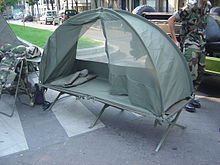Mosquito net

Mosquito nets (also mosquito nets or bed nets ) protect resting people from contact with insects. They are mainly used to limit the transmission of diseases by insects (especially mosquitoes , sand flies and flies ). Bed nets can prevent healthy people from being infected with pathogens by infectious carriers and that sick patients pass the pathogens on to uninfected carriers. Among other things, they are an important part of malaria prophylaxis .
Today mosquito nets consist of a fine-meshed polyester or nylon net . Its meshes are small enough to prevent the insects from entering. According to the WHO , the minimum mesh size against malaria mosquitoes should be at least 25 holes per cm². The smaller the mesh size, the higher the protection against small insects (especially sand flies), but the lower the air exchange and comfort. A mosquito net is attached like a tent over the resting area. Since the insects can bite or sting through the net, it must not touch the body.
Mosquito nets that are treated with insecticides ("insecticide-treated nets", ITNs) have been used for malaria prophylaxis since the 1980s. These insecticide-treated bed nets have to be re-impregnated or replaced after a few washes. In the meantime, more durable impregnated nets have been developed ("long-lasting insecticidal nets", LLINs). Here the insecticides are bound with a chemical binding agent so that up to twenty washes or more than three years of use can be possible.
Mostly pyrethroids are used for insecticide-treated bed nets , which deter, switch off or kill the mosquitoes depending on the dose received. The WHO recommends the pyrethroids permethrin , deltamethrin and alphacypermethrin .
Bed nets treated with insecticide are not only effective against flying insects, but also against other insects that attack humans, such as fleas , bed bugs or blood-sucking predatory bugs ( Triatominae ).
As with the use of all insecticides, bed nets treated with them also run the risk of the insects affected becoming resistant. We are therefore constantly working on the development of new, both chemical and biological insecticides that are safe enough for the user to be able to use them in bed nets.
Alternatives
Mosquito nets impede air circulation, which is why using them in tropical areas can be uncomfortable. Apart from staying in air-conditioned rooms, however, there are hardly any alternatives that are similarly efficient for the personal protection of a resting person.
Even highly effective repellents are rubbed off during sleep and lose their protective effect too quickly.
Fly screens are often too wide-meshed. In addition, it is difficult to prevent insects from entering through open doors.
Pyrethroids are also a deterrent to insects in the gas phase. Releasing them from coils of incense, special lamps or electrically heated vaporizers can significantly reduce the stab load. In higher concentrations, however, they can cause irritation of the respiratory tract, among other things; their use in the presence of pregnant women, infants or small children should be avoided.
literature
- Instructions for treatment and use of insecticide-treated mosquito nets. (PDF file; 1.43 MB) World Health Organization (WHO), Geneva 2002. WHO / CDS / WHOPES / GCDPP / 2002.4
- Insecticide-treated mosquito nets: a WHO Position Statement. (PDF file; 1.05 MB) World Health Organization (WHO), Geneva 200?
- Long-lasting insecticidal net for malaria prevention. A manual for malaria program managers. Trial edition. (PDF file; 2.12 MB) World Health Organization (WHO), Geneva 2007
- A. Rose & U. Kröckel: Prevention of vectorially transmitted infections. In: B. Rieke, Th. Küpper & CM Muth (eds.): Modern travel medicine. Handbook for doctors, pharmacists, travelers. Gentner Verlag, Stuttgart 2010, 326–337. ISBN 978-3-87247-708-8 (Book chapters available online.)
